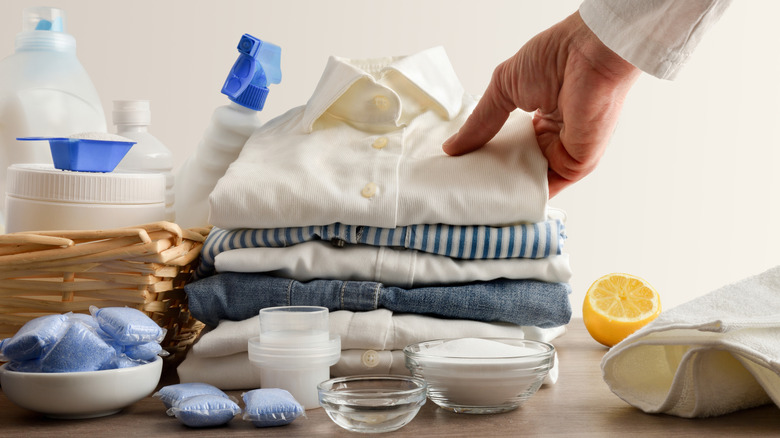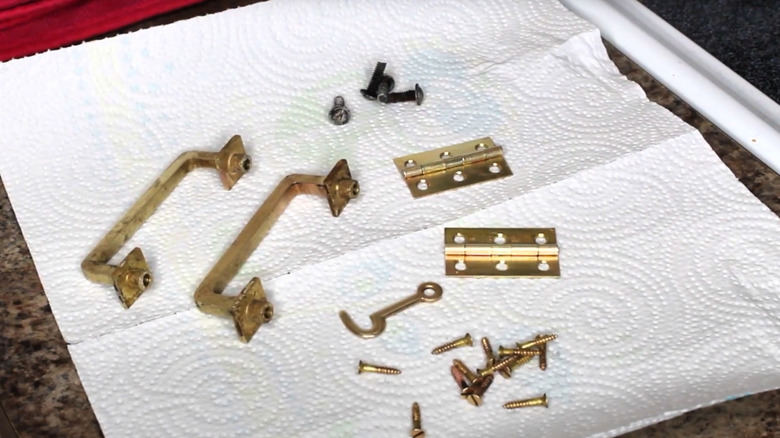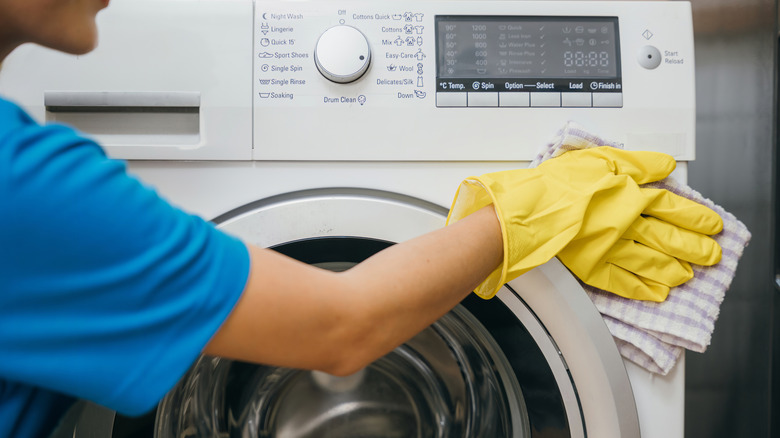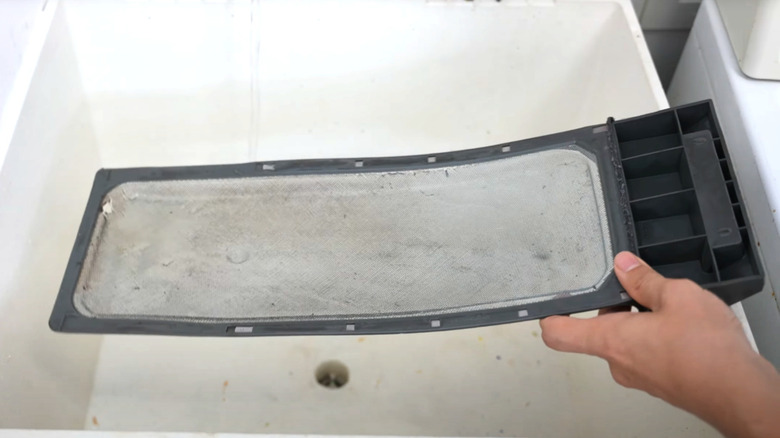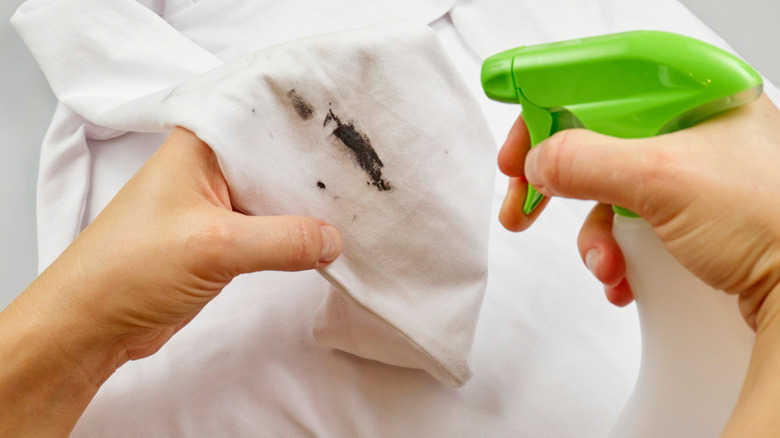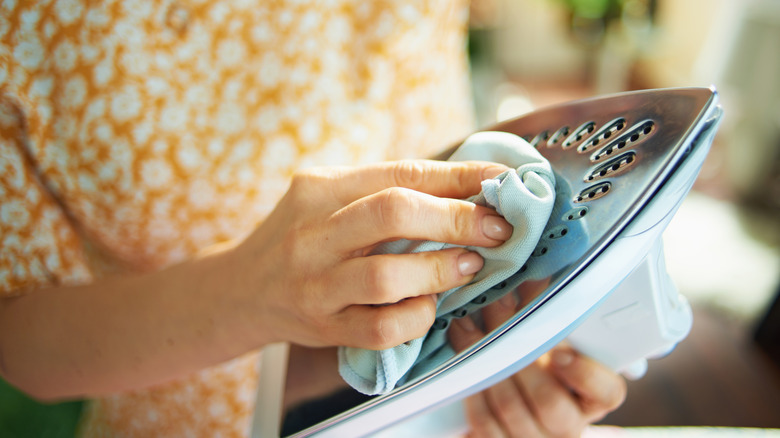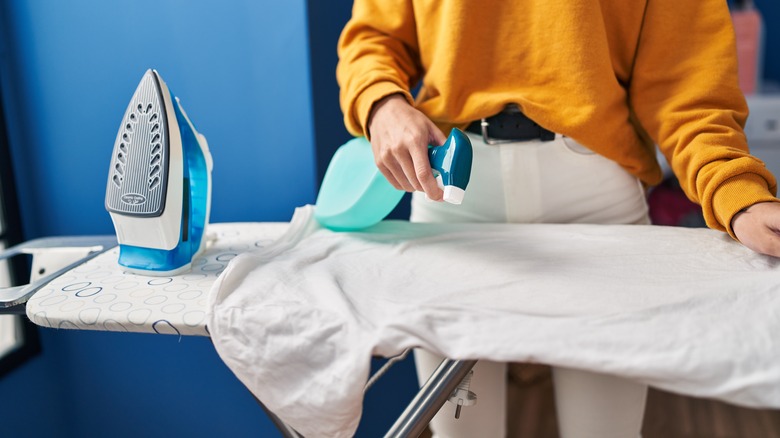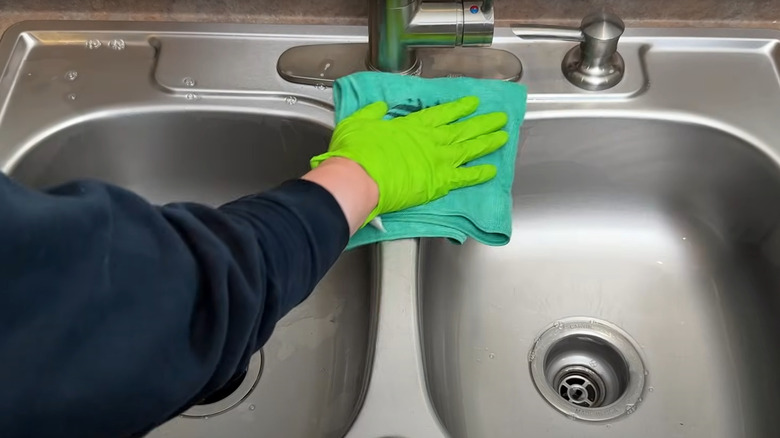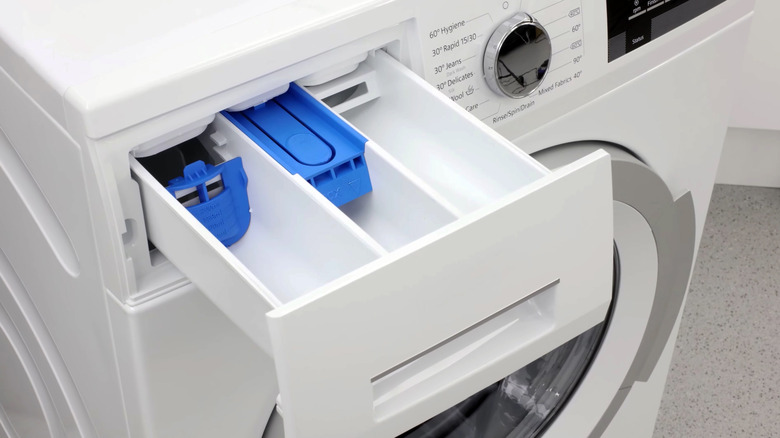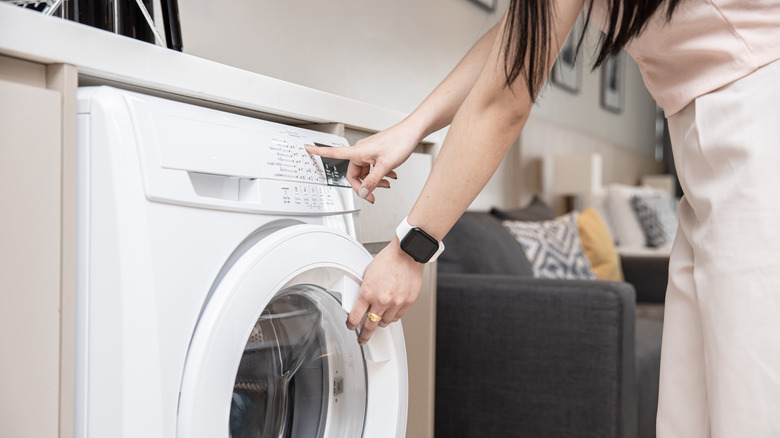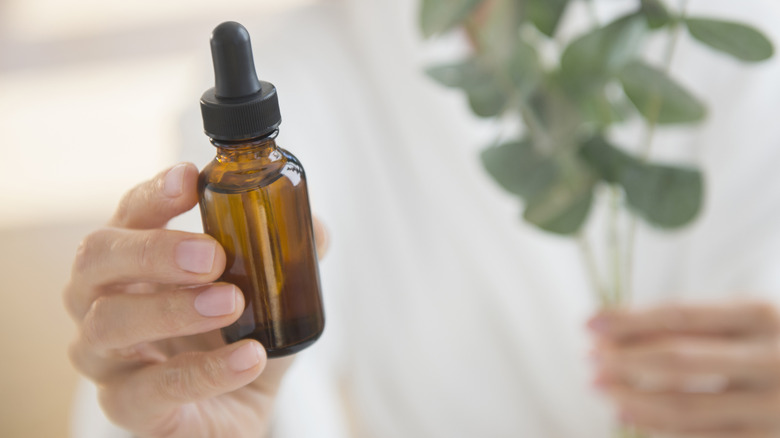7 Ways To Use Vinegar Around Your Laundry Room (& 3 To Avoid)
We may receive a commission on purchases made from links.
Vinegar is a go-to ingredient for household cleaning. Apple cider, white wine, and white distilled vinegar are particularly useful for various tasks in laundry rooms. When diluted or combined with other ingredients, vinegar cleans, deodorizes, lifts tarnish, and sanitizes. Although vinegar can be a versatile cleaning and laundry tool, there are a few DIY hacks to avoid. Do your due diligence before using vinegar on your laundry room appliances, clothes, decor, fixtures, and tools.
Below are seven ways you should and three ways you should not use vinegar in a laundry room. There are plenty of genius tips for using vinegar in laundry, but knowing when to hold back is important. Keep in mind that many of the listed methods refer to the aforementioned kitchen-strength vinegar, not all-purpose or cleaning vinegar. Formulas made explicitly for cleaning are more concentrated and acidic, and have a higher percentage of acetic acid (usually 6%, where distilled vinegar contains 5% acetic acid). Industrial-strength formulas are even more potent (often containing around 30% acetic acid) and simply aren't as versatile and safe to use as watered-down cooking vinegars. Armed with this knowledge, read on to learn more about how to use vinegar to clean items in your laundry room.
Do: Dilute vinegar to clean and shine cabinet knobs and handles
Tarnish is a grimy buildup that appears on most metals, including aluminum, brass, copper, silver, and steel. These metals are common materials used in laundry cabinet hardware, and it's hard to prevent the oxidized buildup since it occurs naturally from exposure to air. Acidic substances like vinegar are effective for removing tarnish (and rust) because of their low pH. An acidic, low pH breaks down the chemical bonds through a double displacement reaction where certain electrons swap places with each other to dissolve the tarnish, restoring cabinet knobs and handles to their original shiny appearance.
However, you need to think carefully before using vinegar to clean some metal surfaces. Do not use vinegar if your knobs and handles have a smudge-free or oleophobic finish. The acidic qualities could eat away more than tarnish and take off these outer layers. Always start with a mild solution, and add more vinegar only if the tarnish doesn't come off. Begin with one part white vinegar to eight parts distilled water. It may be easier to unscrew the hardware and let it sit in diluted vinegar for a few minutes before rubbing it with a microfiber cloth. You can also use other kinds of acidic household products to successfully clean metal cabinet pulls. People swear by various combinations of baking soda, flour, lemon juice, toothpaste, salt, and vinegar for polishing, and there is constant discussion over which method is the best. Just take note, alkaline substances (like baking soda) and acidic substances (like vinegar and lemon juice) should be applied consecutively and/or separately, as they can cancel each other's pH, which is the mechanism behind their cleaning power.
Do: Remove mildew from washer and dryer exteriors
Vinegar is a mild acid, but it can kill 82% of mold species, according to Mississippi State University. Since vinegar is budget-friendly, non-toxic, and available at most convenience and grocery stores, it's a good starting place to tackle mold and mildew buildup on laundry machines. Vinegar's acidic qualities make it the right choice for the job. The acetic acid disrupts fungi and microorganism growth, making it harder for mold to regrow once scrubbed away. Diluted vinegar with reduced strength also deters mold, although not as effectively.
To make a mild DIY cleaner, mix equal parts vinegar and warm water in a spray bottle. Spray the mix onto the mildewed surfaces and let it sit for a while, then wipe clean. Watered down vinegar isn't as effective for mold but prevents accidental damage to surfaces. Diluted formulas are safe for plastics, which are common materials used on laundry machine exteriors. Be more cautious using this formula on stainless steel laundry machines, since they may have too delicate of a finish for vinegar. Also, be conscious not to get your cleaning solution on the controls or control panel. Laundry machine manufacturers typically recommend that the controls be cleaned with a damp cloth. You should also use a soft cloth while cleaning the rest of the washer and dryer exterior to avoid accidentally scratching the painted finish. Kimberly-Clark's Wypall Microfiber Cloths are a little pricey but have a great reputation for being durable, gentle, and reusable long-term.
Do: Soak a lint trap in a vinegar solution to dislodge stubborn lint
Lint traps are simple but one of the most important contraptions in a dryer. They're responsible for trapping lint and debris before it gets sucked into the dryer's exhaust hose. You should empty the lint trap before or after every load and do deeper cleanings twice a year. If there's excessive buildup, white vinegar can help break down hardened residue left behind by dryer sheets, fabric softeners, and leftover detergent. Many laundry detergents have a medium to high pH, making them neutral or alkaline. Since vinegar is acidic, it causes a neutralizing chemical reaction that can help loosen this residue.
Most lint traps feature a wire mesh center and a plastic or metal frame, and both materials are safe to clean in diluted distilled white vinegar. Use this household essential to clean your laundry lint trap by filling your sink with hot water. Add a small amount of dish detergent to make it mildly soapy, and dump a half cup of white vinegar on top. Fully submerge the lint trap and let it soak for about 30 minutes. When you rinse it under warm water, the debris should wash away. If not, soak it longer or use a nail brush to work out the coagulated bits. Do a final rinse, ensuring the water runs completely soap-free before setting the lint trap aside to air dry. Note that if there is a lot of residue built up on your lint trap, it is best to soak in a bucket or basin to avoid letting excessive amounts of gunk potentially clog your drain.
Do: Spot-treat stains with a diluted vinegar solution
Diluted white vinegar is a great way to freshen up your laundry without washing. When watered down, it can counteract alkaline pH stains on clothing. The majority of laundry stains are acidic (like food stains and other organic soils), but there are certain tough-to-budge marks that can result from alkaline substances, such as rust spots, detergent marks, and stains from carbon-based items. Via a neutralizing reaction (and some potential swapping of ions), vinegar can help to loosen the hold of these stubborn marks. Dry cleaning experts also say it can work in "like-removes-like" fashion, and use vinegar to treat certain acidic stains, such as those from red wine and coffee.
However, before you bust out your spray bottle, keep in mind that the vinegar must be diluted since concentrated vinegar is harsh on delicate and dyed fabrics. Laundry brand manager Morgan LaLonde told Martha Stewart, "Using too much vinegar over time takes a toll on your delicate fabrics. It's best used when necessary to remain efficient and keep clothes in their best condition." LaLonde also said this hack is most useful for white fabrics since it brightens them without discoloring.
Taking LaLonde's advice, you can spot-clean most cotton, linen, polyester, and microfiber fabrics, but be careful with rayon and silk. Double-check your clothing's washing instructions, since they may warn to not use vinegar if your garment has elastic or decorative embellishments. Take extra precaution and also do a test spot in an inconspicuous place to make sure there's no staining. Once sure, combine one part vinegar with three parts water, spray onto the mark and give the vinegar some time to sit.
Do: Clean iron soleplates with hot vinegar and a soft cloth
One of the easiest ways to clean an iron is using vinegar. Dust, lint, detergent and spray starch residue, and mineral deposits from hard water can build up on iron soleplates over time. Grime will accumulate even if you use a DIY laundry starch spray made from pantry essentials to help flatten clothing wrinkles. Fortunately, vinegar is perfectly suited to tackle these deposits. As we already mentioned, detergents are generally alkaline. So are hardwater mineral deposits. Many DIY and store-bought spray starches have a neutral to alkaline pH. Applying vinegar exposes these deposits to an acidic solution that helps break down the gunky buildup through a neutralizing reaction, during which hydrogen ions from the acetic acid undergo a double-displacement with available ions in the residue layer, helping to loosen it. Clothing iron brands make their soleplates with metal, which is safe to clean as long as you don't let the vinegar sit for too long.
Start by heating up an equal amount of white vinegar and salt on a stovetop. Mix them evenly together so the salt works in tandem with the vinegar as an abrasive for cutting through debris. Dip a kitchen sponge or cloth into the warm formula and gently wipe away the residue on the soleplate. If you can't get debris out of the soleplate crevices using a sponge, use a cotton swab, pipe cleaner, or toothbrush to get into the narrow spaces. Make sure you wear a pair of heat-resistant housecleaning gloves, like Bamllum's Rubber Kitchen Dishwashing Gloves, to protect your hands from the hot vinegar.
Do: Spray a cloth with vinegar and flatten creases in wrinkled clothing
There are many ways to use cornstarch in your laundry, and some hacks are doable with vinegar too. Instead of using corn starch and water to remove clothing wrinkles, try a diluted vinegar solution. When clothes go through the wash, water molecules cause the fabric to become misshapen and creased. The hot iron breaks up the hydrogen bonds, restoring the material to its flat form. Diluted vinegar helps this process along by breaking down the mineral content in water from the wash cycle. In short, the combination of a hot iron and vinegar creates a chemical reaction that effectively de-wrinkles clothing.
This hack is straightforward: start by mixing equal parts vinegar and water into a spray bottle. Use the spray bottle the same way you would use a store-bought ironing aid. Spray a clean cloth or rag until it's moist, and press it into the wrinkled dry fabric. Lay the iron on each section until it's cool and dry and the garment is wrinkle-free. This is most effective on cotton and linen fabrics, which withstand higher heat. Avoid using this hack on rayon, silk, and other delicate materials since they can be damaged by too much heat or vinegar.
Do: Loosen hard water stains and soap scum around your laundry room sink
Hard water is a common household problem that leaves mineral stains around plumbing equipment. If you have a laundry sink setup and no water softener, you may notice mineral scale on the faucet and sink basin. Mineral scale is mostly made up of calcium carbonate deposits resulting from water with a pH over 8.5. Calcium carbonate can build up on its own, but it can also react with soap and detergents to form hard-to-budge soap scum. Because calcium carbonate and soap scum are alkaline, vinegar's acidic pH level can help to break down resulting deposits via a neutralizing reaction, whereby atoms in the two substances break apart and some of the ions switch places with each other to form new compounds.
White wine vinegar, white distilled vinegar, and apple cider vinegar can all be used to clean sinks. Whichever you choose, dilute it with an equal amount of water to make it safe for acrylic, metal, and porcelain surfaces. Use with care on enamel sinks as they can be easily damaged by harsh cleaners. Avoid using steel wool or rough scrub pads, no matter what material your sink is. You may not notice at first, but combining acidic vinegar and a harsh cleaning tool can leave small scratches that eventually dull the surface. Use a soft microfiber cloth, either the previously mentioned Wypalls or another highly rated option like The Rag Company's Standard Waffle Weave Microfiber Towels.
Take note: Dilute solutions of vinegar will probably not be able to lift thick layers of limescale, so do not expect this trick to work on decades' worth of buildup. If you're struggling to lift the scale, you can also try soaking paper towels or cleaning rags in a dilute vinegar solution, and laying them over the affected area for an hour or so to give the acetic acid time to work on the limescale. If your faucet head is stubbornly caked with buildup, you can try removing it and soaking it in a dilute solution, or tie a plastic bag filled with half vinegar half water around the head.
Don't: Use vinegar as fabric softener unless you have the right machine
There are several reasons why you should stop using fabric softeners for laundry, but many people don't want to give up the soft and fragrant results. Vinegar is a popular substitute that health-conscious bloggers recommend, and it can be better for fabrics. However, vinegar's acidic composition again comes into play. The low pH of acetic acid is not good for washing machine interiors, as it is corrosive and can eat into certain materials such as rubber. The owner of Foothills Appliance Service told Consumer Reports, "With continual use, vinegar can literally melt hoses, causing leaks and thereby possibly all kinds of additional damage to the house." Washing machine manufacturers also warn that vinegar can damage the inside rubber gaskets.
However, it might still be possible to use vinegar as a fabric softener if you have a washing machine model with additional features. Many top-load and modern washers have a compartment to add bleach or fabric softener during a wash cycle. These compartments are designed to limit exposure and keep those chemicals from being too harsh on your clothes or the machine itself, making them a potentially suitable place to add vinegar. Before pouring vinegar into a bleach compartment, ensure it's completely clean and free of bleach and chlorine residue. Mixing these two chemicals makes chlorine gas, which is dangerous to inhale.
Don't: Combine bleach with vinegar to remove mold from laundry machines
Almost half of residential homes in the United States show signs of mold, and laundry rooms are especially susceptible. Even if you take steps to make your laundry room brighter, improve its ventilation, and keep your machines in top shape, mold spores still find their way in by clinging to dirty clothes. Bleach and vinegar are not a good duo to eliminate mold, since they release a toxic chlorine gas when mixed together.
Instead of combining bleach and vinegar, washing machine manufacturers recommend using solely vinegar and water to treat the issue. Clean the affected surfaces with a mixture of hot water, distilled white vinegar, a soft cloth, and a toothbrush. If mold is inside the washer tub, run it on the longest hot wash cycle. You can add vinegar if it's a top-load model with a bleach or fabric softener compartment. Some manufacturers, like GE advise the use of vinegar for mold on their washing machine seals — but if you want to play it totally safe, do not use vinegar to clean rubber gaskets unless absolutely necessary. Once done, fully dry off the laundry machine before putting away your cleaning supplies. Leaving it damp is an open invitation for mold and mildew to return.
Don't: Pour vinegar and essential oils directly into the washing machine tub
Yes, you can keep your washing machine sparkling by following cleaning hacks, but always make sure to look up potential caveats. Many people DIY home cleaners by mixing distilled vinegar with water and essential oils. While this combination is usually safe, it shouldn't be poured in an empty washer. Both vinegar and essential oils can pose risks if directly poured where clothes go.
Instead of cleaning and deodorizing the main washer tub with a cupful of vinegar, pour it into one of the dispensers for bleach, detergent, or fabric softener. The vinegar is safe to mix with residual detergent or fabric softener. Do not pour it over bleach residue.
In most cases, don't put essential oils in the mix, even if the fresh fragrance is tempting. Aromatherapy and essential oil sources warn that certain oils can damage gaskets, hoses, and seals, especially if not properly diluted ahead of time. Some essential oils are also flammable, and could be a fire hazard. If you insist on using them, make sure the oil isn't corrosive or flammable. Mix a minimal amount with white vinegar before dumping it in one of the specialized compartments. Less is more when it comes to essential oils; you'll only need about 10 drops for six cups of distilled vinegar.
